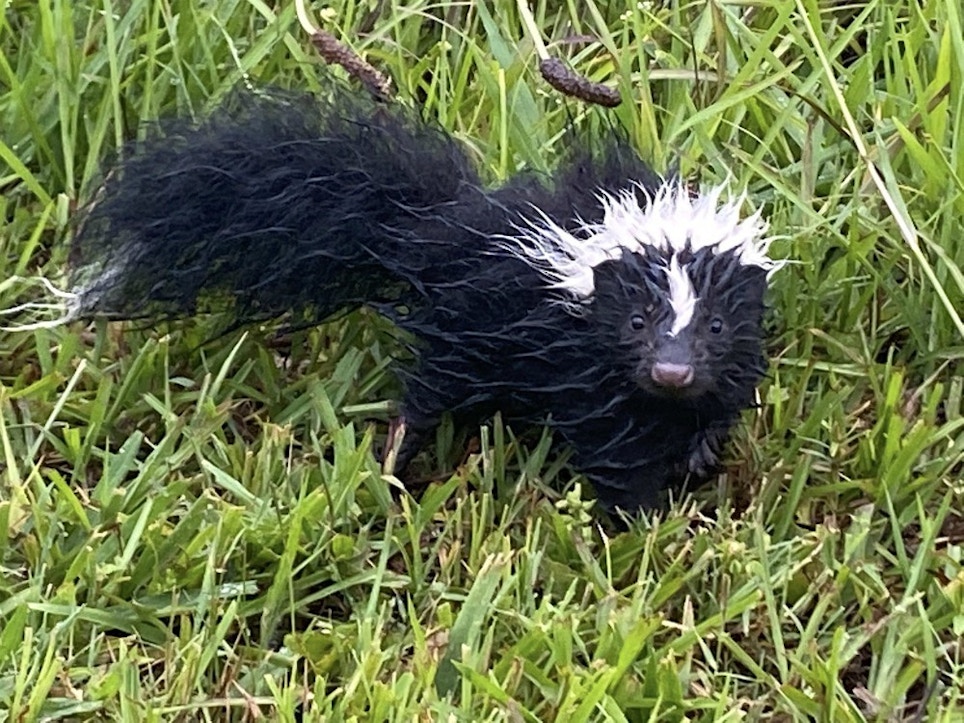
Even baby skunks can douse you with a shot of foul spray from their anal glands, so watch out! (Photo: Alan Clemons)
Skunks may look cute but if you're around one, your overriding thought is to not get sprayed with their foul-smelling oil. What causes skunks to stink so badly?
Spraying is a skunk's defense mechanism. They can bite and scratch but it's rare to do so when attacked. They're wired to turn and lift that long, furry tail before firing a stream of vomit-inducing spray. In an instant, if they feel so compelled, they go from you being, "Hey, kinda cool, a skunk" to stinging eyes and, in many cases, the emptying of your stomach contents.
Fortunately, over the years, I've only encountered a couple of skunks in Alabama. Our most common is the striped skunk. For years, Pepé Le Pew was the only striped skunk I knew about. Since then I've seen a few. The latest, however, was solid white on top with a black belly and legs. It looked like a small version of the American Hog-nosed skunk, but we don't have those.
Skunks have two anal glands that produce a spray that contains chemicals including thiols. Among these chemicals is sulfur, which has the aroma of rotten eggs. If you've ever been to Yellowstone National Park to see the geysers, some of those have a similar albeit less offensive sulfur odor.
How, you may wonder, does a skunk manage to fire a 10- to 15-foot stream of oily-type musk from his tookus? The scent glands are on either side of his anus, which has powerful muscles that can contract and fire the stream. It's not an unlimited supply, though. Skunks have four or five "sprays" before the glands are empty. It takes about 10 days to recharge the glands.
Even if you've never been sprayed chances are good you've smelled a skunk. Every spring and autumn when nighttime temperatures get to about 60 degrees, the aroma is pretty noticeable on one stretch of road near our home. There's a cluster of trees in the road median, which is where I presume some skunks have a den. In that temperature range, too, sometimes at our home I've gotten a whiff of a skunk. I have no idea where it might be. The woods near our home? The woody ditch near the neighborhood pond? No way of telling, to be honest.
Supposedly, skunks can be smelled up to 3.5 miles downwind. I'm not sure about that unless it's open territory but who knows? Charles Darwin recounted this in his Voyage of the Beagle:
We saw also a couple of Zorrillos, or skunks — odious animals, which are far from uncommon. In general appearance, the Zorrillo resembles a polecat, but it is rather larger and much thicker in proportion. Conscious of its power, it roams by day about the open plain, and fears neither dog nor man. If a dog is urged to the attack, its courage is instantly checked by a few drops of the fetid oil, which brings on violent sickness and running at the nose. Whatever is once polluted by it, is for ever useless. Azara says the smell can be perceived at a league distant; more than once, when entering the harbour of Monte Video, the wind being off shore, we have perceived the odour on board the Beagle. Certain it is, that every animal most willingly makes room for the Zorrillo.
The latest skunks I saw didn't spray, thankfully, although they did whirl, turn, glare and bare their teeth. They gave fair warning before possibly unleashing their ultimate defense, which I didn't want to encounter.





